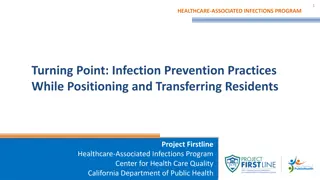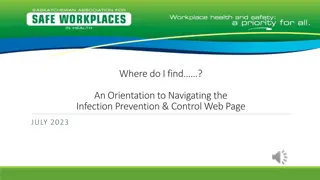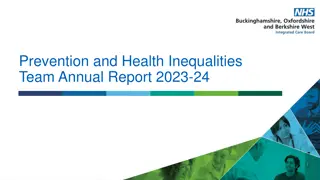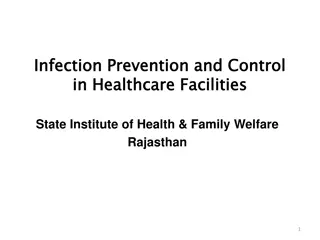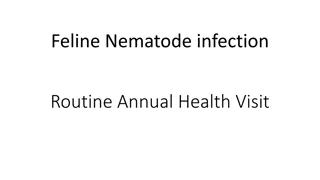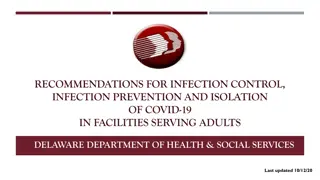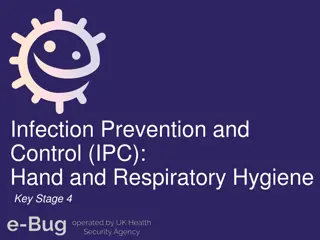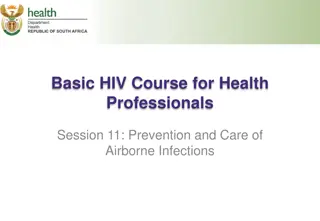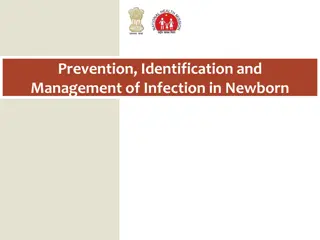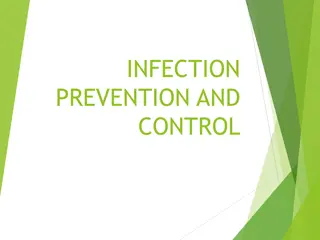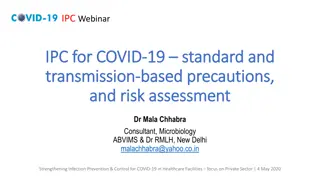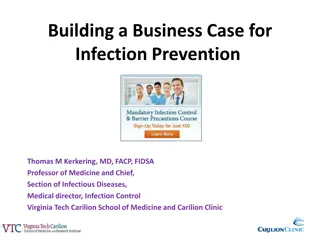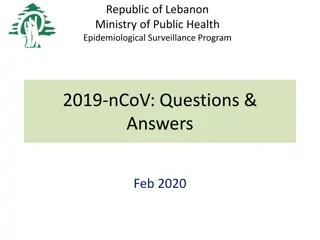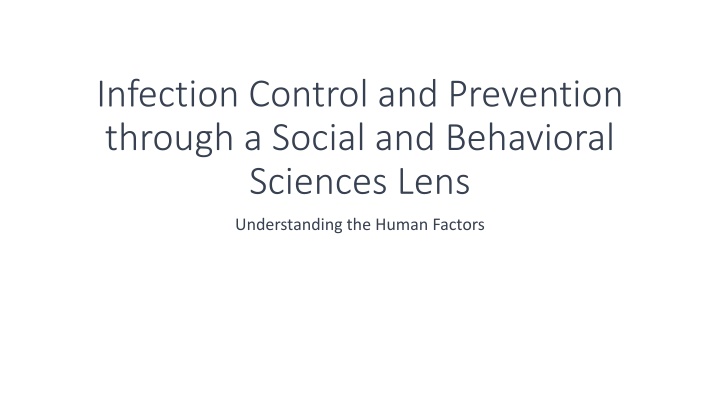
Insights into Infection Control and Prevention through Social Sciences Lens
Explore the influence of social and behavioral factors on infection control, including hand hygiene, vaccination adherence, risk perception, and healthcare norms. Learn how health beliefs, access to resources, and community engagement play crucial roles in preventing healthcare-associated infections.
Download Presentation

Please find below an Image/Link to download the presentation.
The content on the website is provided AS IS for your information and personal use only. It may not be sold, licensed, or shared on other websites without obtaining consent from the author. If you encounter any issues during the download, it is possible that the publisher has removed the file from their server.
You are allowed to download the files provided on this website for personal or commercial use, subject to the condition that they are used lawfully. All files are the property of their respective owners.
The content on the website is provided AS IS for your information and personal use only. It may not be sold, licensed, or shared on other websites without obtaining consent from the author.
E N D
Presentation Transcript
Infection Control and Prevention through a Social and Behavioral Sciences Lens Understanding the Human Factors
Discussion Questions Examining infection control and prevention through a social and behavioral sciences lens offers valuable insights into understanding and addressing the complexities of human behavior and social dynamics in the context of healthcare-associated infections. Understanding Behavior: How do social and behavioral factors influence individual behaviors related to infection control, such as hand hygiene, adherence to vaccination protocols, and compliance with isolation precautions? Perception of Risk: How do individuals perceive the risk of acquiring or transmitting infections, and how does this perception influence their behaviors? Are there cultural or social factors that shape these perceptions differently across populations? Norms and Social Influence: How do social norms and peer influences affect infection control practices within healthcare settings and the broader community? How can positive social norms be leveraged to promote adherence to infection control guidelines? Health Beliefs and Attitudes: How do individuals' beliefs, attitudes, and knowledge about infections and preventive measures impact their behaviors? How can healthcare providers effectively communicate with patients and the public to address misconceptions and promote evidence-based practices? Structural and Environmental Factors: How do structural factors, such as access to healthcare resources, healthcare infrastructure, and socioeconomic status, influence infection control practices and outcomes? How can interventions address these structural barriers to improve infection prevention efforts?
Discussion Questions Continued Health Literacy and Communication: How does health literacy impact individuals' ability to understand and follow infection control guidelines? What strategies can be implemented to enhance health literacy and facilitate effective communication about infection prevention? Behavioral Interventions: What are some effective behavioral interventions for promoting infection control and prevention? How can principles from behavioral economics, social marketing, and behavioral psychology be applied to design interventions that motivate behavior change? Healthcare Provider Behavior: How do social and behavioral factors influence healthcare providers' adherence to infection control protocols and guidelines? What strategies can be employed to enhance healthcare provider compliance and promote a culture of safety within healthcare organizations? Community Engagement and Participation: How can community engagement and participatory approaches be utilized to promote infection control and prevention initiatives at the local level? What are the benefits and challenges of involving communities in these efforts? Sustainable Behavior Change: How can infection control interventions be designed to promote sustainable behavior change over time? What are the key factors that contribute to the long-term success of infection prevention programs? By examining infection control and prevention through a social and behavioral sciences lens, we can develop more comprehensive and effective strategies for reducing healthcare-associated infections and improving patient safety.
Objectives Recognize the influence of social and behavioral factors on infection transmission Explore strategies for incorporating behavioral sciences into infection prevention Analyze case studies illustrating successful interventions
Introduction Understanding the etiology, treatment, and prevention of disease requires integrating proximate biomedical processes as well as the underlying social determinants and bio-psycho-social factors associated with emerging infectious diseases. Although chronic disease has received more attention in social research to date, social factors may be equally if not more decisive in the emergence and re-emergence of infectious disease. Importance of understanding human behavior for effective prevention strategies
Human Behavior and Infectious Disease The linkage between human behaviors and infectious diseases are not always well understood, especially in the beginning 1918 Influenza pandemic HIV/Aids pandemic Covid-19 pandemic All started with unknown etiological agents and human interactions The higher the social activity, the higher rates of infection
Human Behavior and Infectious Disease Social and cultural forces influence almost every aspect of disease transmission, including public health and healthcare s ability to respond The concept of the behavioral immune system posits that susceptible individuals exercise preventative behaviors when faced with the threat of infection Disease avoidance saves the immune system from the costly process of reacting to the invasion of a pathogen. These behaviors include reactions like disgust and avoidance of infectious hosts. Other individual behaviors linked to epidemiological outcomes are correlated with exposure and infection.
Example Higher social activity is linked to an increased likelihood of influenza infection during outbreaks Human behaviors linked to active infections have been more difficult to characterize. Asymptomatic or mildly symptomatic individuals can be central to superspreading events because behaviors do not change during a period of infectiousness For symptomatic infections in humans, disease modelers and policy makers often assume that hosts have fewer contacts or move less than healthy hosts, but data explicitly showing this phenomenon have been limited.
Perception of Risk https://www.ncbi.nlm.nih.gov/pmc/articles/PMC8650764/ https://journals.plos.org/plosone/article?id=10.1371/journal.pone.02 74024 To limit an infectious outbreak, the public must be informed about the infection risk and be motivated to comply with infection control measures. Perceiving a situation as threatening and seeing benefits to complying may be necessary to motivate for compliance.
Risk Perception Risk is typically considered to consist of the probability (or likelihood) of a negative event factored by the severity of the outcome. Perceived risk is the subjective assessment of the two components The protection motivation theory proposes that perceived severity of threat, vulnerability, self-efficacy and response effectiveness facilitates the adaptation of preventive behaviors During a pandemic, threat severity and threat vulnerability may correspond to how people assess the likelihood of being infected and how severe such an event would be.
COVID-19 People may have different motivations for complying with infection control measures. The health belief model posits that people s engagement in precautionary behavior is based on deliberative weighing of costs and benefits of such behavior Compliance often implies a cost for the individual, as it may include avoiding desirable actions such as travel and social gatherings As well as performing undesirable actions such as wearing facemask in public or working from home.
COVID-19 Benefits to compliance are on the other hand shared by everyone, by mitigating the societal impact of the disease. As such, wearing a facemask or keeping physical distance to others may be perceived as a prosocial act, as one incurs inconvenience to oneself for the benefit of the community
Overview of the Health Belief Model Based on this model, people respond appropriately to health and disease prevention messages when they feel: 1. They are exposed to a real danger (perceived sensitivity) 2. And the risk is extremely serious (perceived severity), 3. And when they feel that behavior change has many benefits (perceived benefits) 4. And that they can eliminate barriers to doing health behaviors (perceived barriers), they are more likely to do the behavior.
Overview of Health Belief Model Self-efficacy refers to individuals' judgments of their own abilities to perform an action and can lead them toward adopting health- promoting behaviors and quitting negative health behaviors. Cues to action are stimuli that influence the individuals, leading them to do health behaviors i.e., standard precautions. Application in infection control and prevention Examples of interventions based on the model
Health Belief Model and Infection Prevention Applying the HBM to infection control and prevention in a healthcare setting: 1.Perceived Susceptibility: Educate healthcare workers (HCWs) and patients about the risk of infection and the seriousness of the consequences if infection control measures are not followed. 2.Perceived Severity: Emphasize the potential severity of infections, including the impact on health and the possibility of spreading to others, especially in vulnerable populations. 3.Perceived Benefits: Highlight the benefits of adhering to infection control practices, such as reduced risk of infection, improved patient outcomes, and overall safety in the healthcare environment.
Health Belief Model and Infection Prevention 4. Perceived Barriers: Identify and address barriers to compliance with infection control measures, such as time constraints, lack of resources, or misinformation. 5. Cues to Action: Implement reminders and educational materials that prompt HCWs to engage in infection control behaviors. This could include posters, checklists, and training sessions. 6. Self-Efficacy: Foster confidence among HCWs in their ability to perform infection control practices correctly through training and positive reinforcement.
Case study In some international studies, most prehospital emergency staff have reported low infection control standard precautions, and their knowledge and practice of standard precautions was found to be inadequate. In Iran, prehospital emergency staff are at higher risk of occupational injuries, i.e., blood-borne infections, and most of them do not have good knowledge and practice about the principles of infection prevention. Therefore, educational approach must be considered to increase knowledge and practices of prehospital emergency staff about standard precautions. Although the education affected knowledge, attitude, self-efficacy, and performance in studies other than infection control, education has not yet been done to improve infection control in Iran's emergency staff.
Social Cognitive Theory Social Cognitive Theory (SCT) is a framework for understanding human behavior that emphasizes the role of observational learning, social experience, and reciprocal determinism. Developed by Albert Bandura, SCT posits that learning occurs in a social context and that individuals are active agents who both influence and are influenced by their environment12. Key components of SCT include: Observational Learning: The idea that people can learn new behaviors by observing others. Reciprocal Determinism: The concept that a person s behavior both influences and is influenced by personal factors and the social environment. Self-Efficacy: The belief in one s capabilities to organize and execute the courses of action required to manage prospective situations.
Social Cognitive Theory (SCT) SCT has been applied to a wide range of areas, including education, psychological disorders, health promotion, and marketing, providing valuable insights into how behavior can be shaped and changed within a social context. Application in public health campaigns https://bmchealthservres.biomedcentral.com/articles/10.1186/s1291 3-021-07205-6
Social Cognitive Theory and Infection Prevention SCT can be applied to infection control in a healthcare setting by focusing on the interplay of personal, behavioral, and environmental factors. 1.Personal Factors: Educate healthcare workers (HCWs) on the importance of infection control and the role of their personal beliefs and knowledge in preventing infections. This includes understanding the risks and consequences of not following protocols. 2.Behavioral Factors: Encourage HCWs to model positive infection control behaviors. Use observational learning by highlighting best practices and providing opportunities for HCWs to observe and replicate effective infection prevention techniques. 3.Environmental Factors: Create a supportive environment that facilitates proper infection control practices. This could involve ensuring easy access to hand hygiene stations, providing sufficient personal protective equipment, and designing workflow processes that support adherence to infection control guidelines.
Social Cognitive Theory and Infection Prevention 4. Outcome Expectations: Clarify the positive outcomes of effective infection control, such as patient safety, reduced transmission of infections, and improved overall healthcare quality. 5. Self-Efficacy: Boost HCWs confidence in their ability to execute infection control measures effectively through training, feedback, and reinforcement. 6. Reinforcements: Implement a system of rewards and acknowledgments for HCWs who consistently follow infection control protocols and address any non-compliance constructively.
Social Cognitive Theory and Infection Prevention A study has shown that constructs like self-regulation, outcome expectations, and perceived barriers directly affect preventive behaviors of nosocomial infections in nursing staff1. Another research suggests that using SCT in developing educational programs for critical care nurses can improve their self-confidence and promote knowledge-based practice in infection prevention and control2. By applying these principles, you can create a comprehensive strategy that not only educates HCWs on the how and why of infection control but also supports them in making these behaviors a consistent part of their daily routine.
Theory of Planned Behavior (TPB) The Theory of Planned Behavior (TPB) is a psychological theory that links beliefs to behavior. It suggests that an individual s behavior is determined by their intention to perform the behavior, which is influenced by three key factors: 1.Attitude Toward the Behavior: This refers to the individual s positive or negative evaluation of performing the behavior. 2.Subjective Norms: These are the perceived social pressures to perform or not perform the behavior, influenced by the opinions of people important to the individual. 3.Perceived Behavioral Control: This involves the individual s belief in their capability to perform the behavior, considering the challenges and resources available.
Theory of Planned Behavior TPB is an extension of the Theory of Reasoned Action (TRA), adding the component of perceived behavioral control to account for situations where individuals may not have complete volitional control over their behavior. It has been widely applied in various fields, including health education, to understand and predict behaviors related to smoking, drug use, and other health-related activities. Examples of interventions guided by this theory https://www.ncbi.nlm.nih.gov/pmc/articles/PMC4341863/
Theory of Planned Behavior and Infection Prevention The Theory of Planned Behavior (TPB) can be applied to infection control and prevention in a healthcare setting by influencing healthcare workers (HCWs) intentions and behaviors towards these practices. 1.Attitude Toward the Behavior: Foster positive attitudes in HCWs towards infection control by highlighting the benefits of these practices, such as patient safety and reduced infection rates. 2.Subjective Norms: Strengthen the social pressure HCWs feel to engage in infection control by creating a culture that values these practices. This can be done through leadership endorsement, peer support, and shared beliefs about the importance of infection prevention.
Theory of Planned Behavior and Infection Prevention 3. Perceived Behavioral Control: Enhance HCWs perception of their ability to perform infection control actions effectively. Provide training, resources, and time to ensure that HCWs feel confident and capable of implementing these practices. 4. Intention to Perform the Behavior: Encourage a strong intention to engage in infection control behaviors by aligning attitudes, norms, and perceived control with organizational goals and policies. 5. Behavior: Ultimately, the goal is to translate intention into actual behavior. Monitor compliance and provide feedback to HCWs to reinforce the infection control behaviors.
Theory of Planned Behavior and Infection Prevention Research suggests that interventions based on TPB can effectively change HCWs behaviors related to hand hygiene, which is a critical component of infection control1. By understanding and addressing the factors that influence HCWs intentions, you can develop targeted strategies to improve adherence to infection prevention and control measures in your healthcare setting.
Social Network Analysis Social Network Analysis (SNA) is a methodological approach that uses networks and graph theory to study social structures. It involves mapping and measuring relationships and flows between people, groups, organizations, computers, URLs, and other connected information/knowledge entities. The nodes in the network represent the actors within the network, and the ties show relationships or interactions between the actors.
Social Network Analysis SNA provides both a visual and a mathematical analysis of human relationships. Management consultants use it to help organizations understand the informal connections and networks that can influence or hinder change processes. In public health, it could be used to identify how diseases and health behaviors spread across populations.
2005 study For the first time, sociologists have mapped the romantic and sexual relationships of an entire high school over 18 months, providing evidence that these adolescent networks may be structured differently than researchers previously thought. https://www.sciencedaily.com/releas es/2005/01/050125090026.htm
HIV Outbreak in Scott County IN Scientists at the Centers for Disease Control and Prevention have used a novel disease- mapping method to study how the 2015 HIV outbreak in Scott County was transmitted. A report in the Journal of Infectious Diseases summarizes the agency s findings, such as the fact most people connected to the outbreak were infected before the state declared a public health emergency. Detailed Transmission Network Analysis of a Large Opiate-Driven Outbreak of HIV Infection in the United States | The Journal of Infectious Diseases | Oxford Academic (oup.com)
Social Network Analysis The core idea is that social relationships constitute valuable resources for individuals and can affect an individual s ability to achieve goals, perform tasks, or develop and maintain a desired social identity. SNA can reveal the hidden patterns of people interacting with each other, the strength of those interactions, and the influence they have on one another3. Using networks for targeted interventions https://www.ncbi.nlm.nih.gov/pmc/articles/PMC8133464/
Social Network Analysis and Infection Prevention Social Network Analysis (SNA) can be a powerful tool for infection control and prevention in healthcare settings. Here s how you can apply it: 1.Mapping Contact Networks: Use SNA to map the interactions between healthcare workers, patients, and other staff. This helps identify potential pathways for infection transmission1. 2.Identifying Key Individuals: Determine which individuals are central to the network (e.g., those with the most connections). These individuals can be critical in spreading or controlling infections1. 3.Targeted Interventions: Develop interventions aimed at individuals who are central in the network to efficiently disseminate information and control measures2.
Social Network Analysis and Infection Prevention 4. Enhancing Contact Tracing: Apply SNA to enhance contact tracing efforts by quickly identifying individuals who are likely to be part of transmission chains1. 5. Resource Allocation: Use network data to allocate resources like PPE and training more effectively to those who are most central in the network2. 6. Evaluating Interventions: After implementing control measures, use SNA to evaluate their impact on the network structure and infection transmission patterns. 7. Predicting Outbreaks: Analyze changes in the network to predict potential outbreaks and implement preventive measures proactively.
Social Network Analysis and Infection Prevention By integrating SNA into your infection control strategy, you can gain insights into the complex dynamics of how infections spread within a healthcare setting and tailor your interventions to be more effective. Remember to combine SNA with other epidemiological data and infection control practices for a comprehensive approach.
Communication Strategies Effective communication is crucial in infection prevention within the context of social and behavioral science for several reasons: 1.Promotes Awareness: Clear communication helps ensure that healthcare professionals and the public are aware of the risks associated with infections and the necessary preventive measures1. 2.Facilitates Teamwork: In healthcare settings, teamwork is essential for infection control. Effective communication fosters collaboration among staff, leading to better patient outcomes and increased safety1. 3.Improves Compliance: When communication is clear and consistent, it increases the likelihood that healthcare workers and patients will comply with infection control protocols, thereby reducing the spread of infections2.
Communication Strategies 4. Supports Behavior Change: Behavioral and social sciences draw on effective communication to promote appropriate behavior change, which is vital for controlling the spread of infection2. 5. Enhances Patient Engagement: Educating patients about infection prevention and control makes them an active part of the healthcare team, potentially expanding the reach and effectiveness of infection control measures3. 6. Reduces Misinformation: In the age of information overload, effective communication helps combat misinformation by providing accurate, evidence-based information about infection prevention and control1. Effective communication is a key element in the successful implementation of infection prevention strategies, as it underpins education, collaboration, compliance, and engagement efforts across all levels of healthcare.
Cultural Competence Culture has a profound impact on health behaviors, influencing how individuals perceive health and illness, seek medical care, and adhere to treatment plans. Here are some ways culture affects health behaviors: Health Beliefs and Practices: Cultural beliefs can determine what is considered healthy or unhealthy, influencing daily health practices and lifestyle choices1. Perception of Illness: Different cultures have various ways of conceptualizing illness, which can affect how symptoms are recognized and addressed2.
Cultural Competence Use of Healthcare Services: Cultural norms can influence whether people seek medical help, the type of health services they use, and their relationship with healthcare providers3. Communication with Healthcare Providers: Culture shapes communication styles, which can impact the effectiveness of the patient- provider interaction and the delivery of healthcare services4. Response to Treatment: Cultural attitudes toward certain treatments can affect adherence to prescribed medical regimens and willingness to follow preventive measures. Understanding the impact of culture on health behaviors is crucial for healthcare providers to deliver culturally competent care and for public health professionals to design effective health promotion interventions.
Strategies to be Culturally Competent in Infection Prevention Cultural competence in an infection control program involves understanding and respecting the diverse cultural factors that influence patients and healthcare workers attitudes and behaviors towards health practices. Here are some strategies to enhance cultural competence in such settings: 1.Define Culture Broadly: Recognize that culture encompasses not just race and ethnicity, but also language, religion, gender, sexual orientation, age, and socioeconomic status1. 2.Value Clients Cultural Beliefs: Show respect for the cultural beliefs and practices of patients and staff, and consider how these beliefs may influence their approach to healthcare and infection control1. 3.Recognize Complexity in Language Interpretation: Ensure that language services are available to facilitate accurate communication between patients and healthcare providers, especially when discussing complex medical information1.
Strategies to be Culturally Competent in Infection Prevention 4. Facilitate Learning Between Providers and Communities: Engage in ongoing education and training on cultural competence for all healthcare staff. Encourage learning about the communities served by the healthcare facility. 5. Involve the Community: Work with community members to define and address service needs, which can lead to more effective and culturally sensitive infection control measures1. 6. Collaborate with Other Agencies: Partner with local organizations and agencies that have expertise in cultural competence to enhance the effectiveness of infection control programs1.
Strategies to be Culturally Competent in Infection Prevention 7. Professionalize Staff Hiring and Training: Incorporate cultural competence into hiring practices and professional development. This includes training staff on cultural sensitivity and awareness1. 8. Institutionalize Cultural Competence: Make cultural competence a core part of the healthcare organization s mission and practice. This includes developing policies and procedures that support culturally competent care1. By implementing these strategies, healthcare settings can improve their infection control programs by making them more responsive to the cultural needs of their diverse patient populations and staff. This can lead to better health outcomes and a more inclusive healthcare environment.
Cultural Competence Examples of successful culturally tailored interventions https://www.ncbi.nlm.nih.gov/books/NBK216037/#:~:text=Cultural% 20health%20beliefs%20affect%20how,care%20interventions%2C%20 and%20treatment%20adherence.
Behavioral Interventions in Healthcare Settings To be effective in primary care, a behavioral intervention should: Include a patient engagement component. Skipping right to treatment doesn t work. Be time efficient, running no more than 20-30 minutes a visit. Follow a structure-based approach. A modularized treatment with clear steps keeps the provider and patient on track despite the distractions in primary care.
Behavioral Interventions in Healthcare Settings Minimize required clinical training. The treatment should be able to be administered by non-specialists who work in a health care team. Be relevant and applicable to the diverse patient populations found in primary care. Have a substantial research evidence-base. Of the multiple behavioral interventions in existence, only a few have been proven to work in primary care including Problem Solving Therapy-Primary Care, Cognitive Behavioral Therapy, Interpersonal Counseling, and Behavioral Activation.
The Impact of Organizational Culture on Infection Control Organizational culture significantly impacts infection control within healthcare settings. A positive safety culture is associated with improved infection prevention and control (IPC) processes and outcomes, including reduced healthcare-associated infections (HAIs). Key elements of an effective organizational culture for infection control include: Leadership Commitment: Leaders play a crucial role in setting priorities and allocating resources for IPC measures1. Employee Engagement: When staff are actively involved in IPC efforts, adherence to safe practices increases2.
The Impact of Organizational Culture on Infection Control Communication: Open and clear communication channels help disseminate IPC guidelines effectively1. Education and Training: Continuous learning opportunities ensure that staff are up-to-date with the latest IPC practices1. Feedback and Improvement: Regular feedback mechanisms allow for the monitoring and enhancement of IPC strategies1. Studies have shown that safety culture improvements are often linked to successful interventions, suggesting a bidirectional relationship where a positive culture contributes to IPC success and effective interventions enhance the culture1. However, challenges remain in empirically establishing these relationships due to methodological limitations in current research1.
Case Studies Present case studies showcasing the successful integration of social and behavioral sciences in infection control Discuss the outcomes and lessons learned https://aricjournal.biomedcentral.com/articles/10.1186/s13756-020- 0695-z
Ethical Considerations In healthcare settings, ensuring equity is essential to promote fair and just access to care for all individuals, regardless of their background or circumstances. Here are some ethical principles and strategies that healthcare organizations can adopt to enhance equity in their interventions: 1.Embrace Equity as Foundational: 1. Recognize that equity should be at the core of all decision-making processes. 2. Prioritize equitable outcomes over equal treatment. 2.Embody Anti-Racism and Anti-Oppression: 1. Actively address systemic racism, discrimination, and bias. 2. Create a safe and inclusive environment for patients and staff. 3.Establish and Maintain Infrastructure: 1. Develop policies, procedures, and structures that promote equity. 2. Allocate resources to address disparities and social determinants of health.

